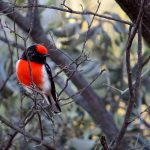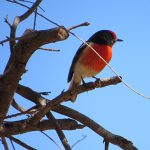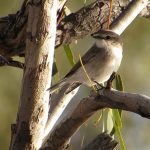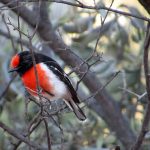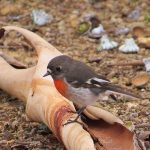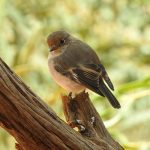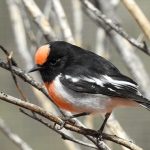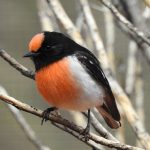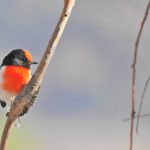RED-CAPPED ROBIN
The Red-capped Robin is a small passerine bird native to Australia, renowned for its striking appearance and endearing behaviors. Let’s embark on a journey to discover the life of this charming little bird.
Picture, if you will, a landscape bathed in the golden light of dawn, where the eucalyptus trees stand tall against a clear blue sky. Amidst the gentle rustle of leaves, a flash of brilliant red catches your eye. This vibrant hue belongs to the male Red-capped Robin, his head adorned with a vivid scarlet cap that contrasts sharply with his black back and wings. The females and juveniles, while more subdued in their coloring, are equally delightful with their soft brown plumage and a subtle reddish tint on their caps.
At a mere 11 to 13 cm in length, these birds may be small, but their presence is undeniable. They are often seen perched proudly on low branches or foraging on the ground, their quick movements a dance to the rhythm of the bushland.
The Red-capped Robin’s diet consists mainly of insects and small arthropods, which they skillfully snatch up using their slender, pointed beaks.
During the breeding season, which typically spans from August to November, the male Red-capped Robin becomes a symbol of dedication. He embarks on a courtship display, showing off his bright plumage and singing a sweet, melodic tune to attract a mate. Once paired, the female takes on the task of building a neat, cup-shaped nest, often situated in the fork of a tree or shrub. Here, she will lay two to three eggs, which she incubates with care while her partner stands guard and forages for food.
The habitat of the Red-capped Robin is diverse, ranging from dry woodlands to arid scrublands, but always with a preference for areas with scattered trees and shrubs that provide both perching and nesting sites. They are particularly fond of regions where bushfires have passed through, as these environments tend to attract a plethora of insects, making for a veritable feast for these agile hunters.
Conservation-wise, the Red-capped Robin is considered to be of least concern, but like many of Australia’s native species, it faces threats from habitat loss and degradation. Feral animals and competition from more aggressive bird species also pose challenges to their survival.
To protect these charismatic birds, it is crucial to maintain their natural habitats and support conservation efforts that promote a healthy ecosystem. By understanding the importance of biodiversity and the interconnectedness of all living things, we can ensure that the Red-capped Robin continues to grace the Australian landscape with its vivid beauty and lively song.
In sharing the story of the Red-capped Robin, we are reminded of the wonders that exist in our natural world and the responsibility we hold to preserve it for generations to come.

